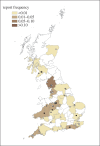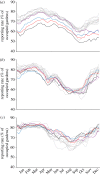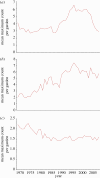The emergence and spread of finch trichomonosis in the British Isles
- PMID: 22966140
- PMCID: PMC3427565
- DOI: 10.1098/rstb.2012.0130
The emergence and spread of finch trichomonosis in the British Isles
Abstract
Finch trichomonosis, caused by the protozoal parasite Trichomonas gallinae, was first recognized as an emerging infectious disease of British passerines in 2005. The first year of seasonal epidemic mortality occurred in 2006 with significant declines of greenfinch Carduelis chloris and chaffinch Fringilla coelebs populations. Here, we demonstrate that large-scale mortality, principally of greenfinch, continued in subsequent years, 2007-2009, with a shifting geographical distribution across the British Isles over time. Consequent to the emergence of finch trichomonosis, the breeding greenfinch population in Great Britain has declined from ca 4.3 million to ca 2.8 million birds and the maximum mean number of greenfinches (a proxy for flock size) visiting gardens has declined by 50 per cent. The annual rate of decline of the breeding greenfinch population within England has exceeded 7 per cent since the initial epidemic. Although initially chaffinch populations were regionally diminished by the disease, this has not continued. Retrospective analyses of disease surveillance data showed a rapid, widespread emergence of finch trichomonosis across Great Britain in 2005 and we hypothesize that the disease emerged by T. gallinae jumping from columbiforms to passeriforms. Further investigation is required to determine the continuing impact of finch trichomonosis and to develop our understanding of how protozoal diseases jump host species.
Figures







Similar articles
-
Detection of the European epidemic strain of Trichomonas gallinae in finches, but not other non-columbiformes, in the absence of macroscopic disease.Parasitology. 2016 Sep;143(10):1294-300. doi: 10.1017/S0031182016000780. Epub 2016 May 16. Parasitology. 2016. PMID: 27180976
-
Evidence of spread of the emerging infectious disease, finch trichomonosis, by migrating birds.Ecohealth. 2011 Jun;8(2):143-53. doi: 10.1007/s10393-011-0696-8. Epub 2011 Sep 21. Ecohealth. 2011. PMID: 21935745
-
An outbreak of trichomonosis in European greenfinches Chloris chloris and European goldfinches Carduelis carduelis wintering in Northern France.Parasite. 2019;26:21. doi: 10.1051/parasite/2019022. Epub 2019 Apr 8. Parasite. 2019. PMID: 30957740 Free PMC article.
-
Prevalence of Trichomonas gallinae in Birds of Iran and its Pathological Findings: A Review study.Arch Razi Inst. 2024 Jun 30;79(3):445-448. doi: 10.32592/ARI.2024.79.3.445. eCollection 2024 Jun. Arch Razi Inst. 2024. PMID: 39736939 Free PMC article. Review.
-
Health hazards to wild birds and risk factors associated with anthropogenic food provisioning.Philos Trans R Soc Lond B Biol Sci. 2018 May 5;373(1745):20170091. doi: 10.1098/rstb.2017.0091. Philos Trans R Soc Lond B Biol Sci. 2018. PMID: 29531146 Free PMC article. Review.
Cited by
-
Prevalence Study of Trichomonas gallinae in Domestic Pigeons in Northeastern Beijing and Experimental Model of Trichomoniasis in White King Squabs Measuring In Situ Apoptosis and Immune Factors in Crop and Esophagus.Animals (Basel). 2024 Jun 25;14(13):1869. doi: 10.3390/ani14131869. Animals (Basel). 2024. PMID: 38997981 Free PMC article.
-
Fecal parasite risk in the endangered proboscis monkey is higher in an anthropogenically managed forest environment compared to a riparian rain forest in Sabah, Borneo.PLoS One. 2018 Apr 9;13(4):e0195584. doi: 10.1371/journal.pone.0195584. eCollection 2018. PLoS One. 2018. PMID: 29630671 Free PMC article.
-
Trichomonas stableri n. sp., an agent of trichomonosis in Pacific Coast band-tailed pigeons (Patagioenas fasciata monilis).Int J Parasitol Parasites Wildl. 2013 Dec 28;3(1):32-40. doi: 10.1016/j.ijppaw.2013.12.002. eCollection 2014 Apr. Int J Parasitol Parasites Wildl. 2013. PMID: 24918075 Free PMC article.
-
Genomic Epidemiology and Management of Salmonella in Island Ecosystems Used for Takahe Conservation.Microb Ecol. 2017 Oct;74(3):735-744. doi: 10.1007/s00248-017-0959-1. Epub 2017 Mar 30. Microb Ecol. 2017. PMID: 28361266
-
Using host species traits to understand the consequences of resource provisioning for host-parasite interactions.J Anim Ecol. 2018 Mar;87(2):511-525. doi: 10.1111/1365-2656.12765. Epub 2017 Nov 13. J Anim Ecol. 2018. PMID: 29023699 Free PMC article.
References
-
- Daszak P., Cunningham A. A., Hyatt A. D. 2000. Emerging infectious diseases of wildlife: threats to biodiversity and human health. Science 287, 443–44910.1126/science.287.5452.443 (doi:10.1126/science.287.5452.443) - DOI - DOI - PubMed
-
- Jones K. E., Patel N. G., Levy M. A., Storeygard A., Balk D., Gittleman J. L., Daszak P. 2008. Global trends in emerging infectious diseases. Nature 451, 990–99310.1038/nature06536 (doi:10.1038/nature06536) - DOI - DOI - PMC - PubMed
-
- Williams E. S., Yuill T., Artois M., Fischer J., Haigh S. A. 2002. Emerging infectious diseases in wildlife. Rev. Sci. Tech. off Int. Epiz. 21, 139–157 - PubMed
-
- Hochachka W. M., Dhondt A. A. 2000. Density-dependent decline of host abundance resulting from a new infectious disease. Proc. Natl Acad. Sci. USA 97, 5303–530610.1073/pnas.080551197 (doi:10.1073/pnas.080551197) - DOI - DOI - PMC - PubMed
-
- LaDeau S. L., Kilpatrick A. M., Marra P. P. 2007. West Nile virus emergence and large-scale declines of North American bird populations. Nature 447, 710–71310.1038/nature05829 (doi:10.1038/nature05829) - DOI - DOI - PubMed
Publication types
MeSH terms
LinkOut - more resources
Full Text Sources

